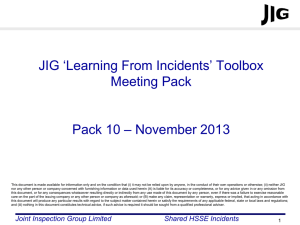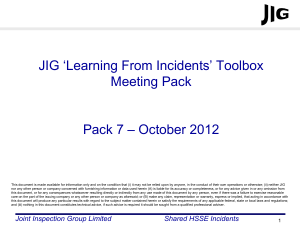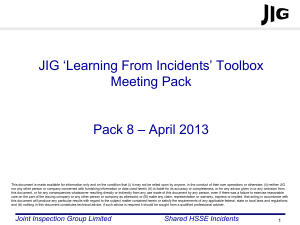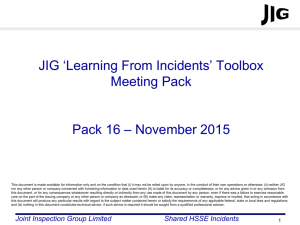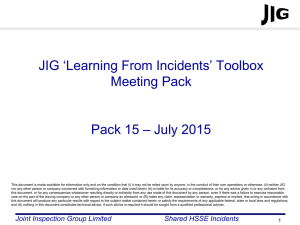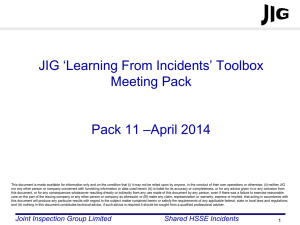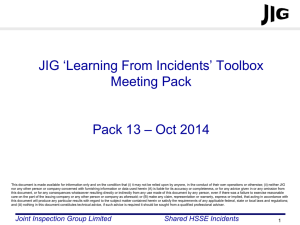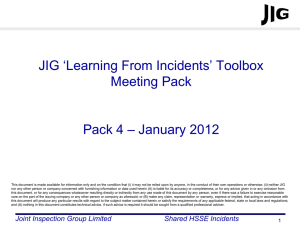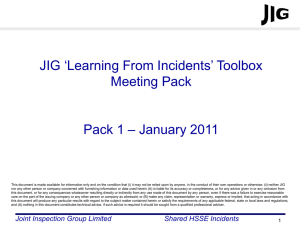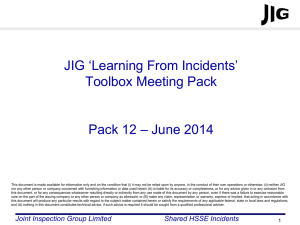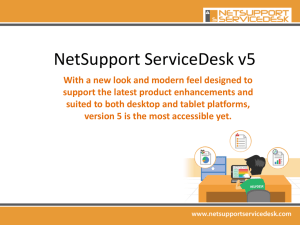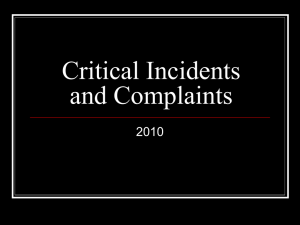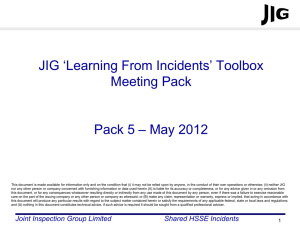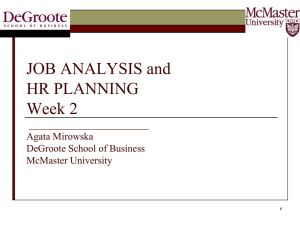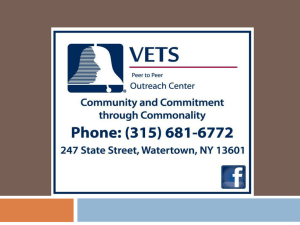JIG LFI Toolbox Pack 9 - Joint Inspection Group
advertisement
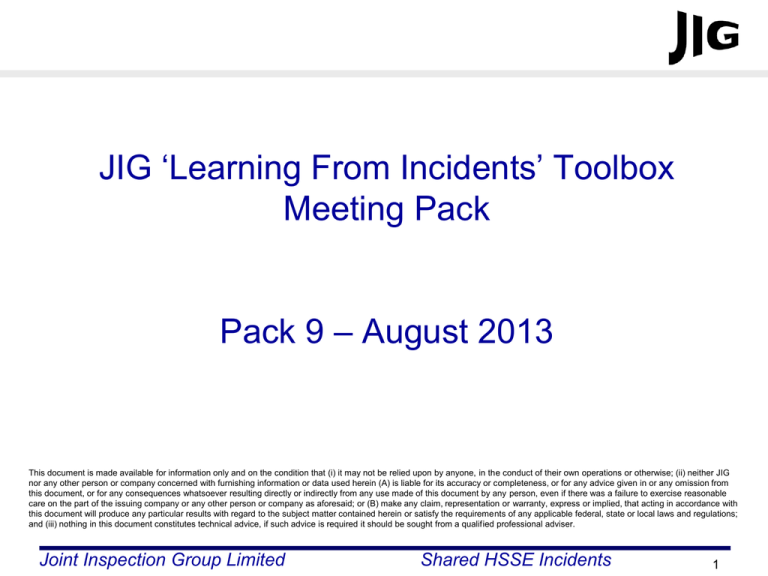
JIG ‘Learning From Incidents’ Toolbox Meeting Pack Pack 9 – August 2013 This document is made available for information only and on the condition that (i) it may not be relied upon by anyone, in the conduct of their own operations or otherwise; (ii) neither JIG nor any other person or company concerned with furnishing information or data used herein (A) is liable for its accuracy or completeness, or for any advice given in or any omission from this document, or for any consequences whatsoever resulting directly or indirectly from any use made of this document by any person, even if there was a failure to exercise reasonable care on the part of the issuing company or any other person or company as aforesaid; or (B) make any claim, representation or warranty, express or implied, that acting in accordance with this document will produce any particular results with regard to the subject matter contained herein or satisfy the requirements of any applicable federal, state or local laws and regulations; and (iii) nothing in this document constitutes technical advice, if such advice is required it should be sought from a qualified professional adviser. Joint Inspection Group Limited Shared HSSE Incidents 1 Learning From Incidents How to use the JIG ‘Learning From Incidents’ Toolbox Meeting Pack • The intention is that these slides promote a healthy, informal dialogue on safety between operators and management. • Slides should be shared with all operators (fuelling operators, depot operators and maintenance technicians) during regular, informal safety meetings. • No need to review every incident in one Toolbox meeting, select 1 or 2 incidents per meeting. • The supervisor or manager should host the meeting to aid the discussion, but should not dominate the discussion. • All published packs can be found in the publications section of the JIG website (www.jigonline.com) Joint Inspection Group Limited Shared HSSE Incidents 2 Learning From Incidents For every incident in this pack, ask yourselves the following questions: • What is the potential for a similar type of incident at our site? • How do our risk assessments identify and adequately reflect these incidents? • What prevention measures are in place and how effective are they (procedures and practices)? • what mitigation measures are in place and how effective are they (safety equipment, emergency procedures)? • What can I do personally to prevent this type of incident? Joint Inspection Group Limited Shared HSSE Incidents 3 Lifting platform hit aircraft wing (LFI 2012-04) Incident Summary - A pilot approached an operator and asked to use the lifting platform to inspect the wing area. The operator agreed to assist when fuelling was ended and raised the platform with the pilot inside. Operator raised the platform a bit more as the pilot could not see the whole wing area, causing a blanking screw on the platform to strike the landing flap. Causes – • • • Blanking screw of the pipe Operator used fuelling equipment for a non standard operation The operator was not authorised and therefore not trained for this specific task The safety devices (proximity sensors) on the platform were not designed for this task and therefore did not provide any protection Discussion Points – • • • How would you handle any requests to perform activities beyond standard fuelling ? (e.g. staff empowered to refuse such requests and instructed to inform supervisors) Would there be any situations where it would be appropriate to use fuelling equipment for non fuelling tasks ? What supervision/observation is undertaken to ensure that staff are performing tasks in accordance with company procedures ? Damage to aircraft flap Can you think of any similar situations that YOU have experienced or witnessed? Did you report it? Joint Inspection Group Limited Shared HSSE Incidents 4 Ankle Sprain from fall on fuelling steps (LFI 2013-02) Incident Summary – The operator had connected an underwing refuelling hose to an Airbus A320 and was descending the steps of a mobile refuelling platform when he received a call on his portable two-way radio. As he reached up to the lapel microphone to answer the call, he became distracted and missed the last step of the stairs, losing his balance and falling to the ground, injuring his right ankle. The original steps design had been modified and available tread was limited so that only half the foot could be placed on the step when descending Causes – • • • Operator was using radio communications equipment while descending the steps. Operator did not maintain 3 points of contact whilst descending steps The refuelling stairs did not comply with a recognised design standard. Discussion Points – • • • • When should you be able to use radio equipment and other two way communication equipment ? What controls should be in place ? What other distractions could lead to an incident of this nature. How could these distractions impact other tasks ? How do you determine whether your steps and ladders are fit for purpose What is the safest way of ascending and descending ladders, steps, stairs etc.? Can you think of any similar situations that YOU have experienced or witnessed? Did you report it? Joint Inspection Group Limited Shared HSSE Incidents 5 Electrical burn from working on live equipment (LFI 2013-03) Incident Summary – A contract electrician opened an electrical panel to confirm the position of the circuit breaker leading to a faulty motor. He accessed the panel without informing the shift supervisor and worked on a live system without having a valid work permit or verifying the isolation. While doing this, he was exposed to an electric spark resulting in minor skin burns to his right hand, face and neck. Underlying Causes – • The access to the electric panel room was not controlled (no door or locks). • The annual electrical inspection of this site did not highlight the existence of the non-insulated wires. • Site staff failed to control the work and implement and apply the Permit to Work & Isolation procedure, despite having undertaken training a few weeks before Discussion Points – • How do you ensure there is controlled access to the electric panel rooms i.e. a lock & key arrangement, warning signs of “Entry by Authorized Persons ONLY” ? • What is your site procedure to ensure faulty equipment is reported and that action is taken in a timely manner ? Do you withdraw equipment from service and tag equipment when critical issues are identified ? • How effective is the work permitting and / or job safety analysis process at your Site? How do you ensure staff and contractors follow these? • How effective are your arrangements for managing contractors i.e. Planning the work, choosing a contractor, controlling their work on site, keeping a check and reviewing the work? Can you think of any similar situations that YOU have experienced or witnessed? Did you report it? Joint Inspection Group Limited Shared HSSE Incidents 6 Ladder blown over by jet blast hitting operator in face (LFI 2013-04) Incident Summary – During an aircraft fuelling an Operator received bruises and swelling when a ladder he was using was blown over as a result of jet blast from another plane leaving the terminal area. The fuelling operation was in progress with the hose connected and the Operator was at ground level next to the fuelling ladder. The aircraft responsible for the jet blast was approximately 80m away. The fuelling operator turned away from the blast to afford some protection however was struck in the face by the aluminium fuelling ladder. Underlying Causes – • • Excessive jetblast was a result of a combination of the following: airport layout, aircraft pushed back beyond pushback lines, excessive thrust by the pilot. Some airport configurations increase the exposure to jet blast. Jet blast has been responsible for serious injuries including one at this particular airport 2 years earlier. Discussion Points – • • • • Are you and your team aware of potential Jet Blast and where this can happen at your site? Are your fuelling ladders fit for purpose ? Do you know of any incidents where they have moved in high wind conditions or due to jet blast ? Ask yourself and your team “what is occurring in my environment that can impact the task I am involved with and the safety of me and those around me?” Which stakeholders could you work with to improve safety at your airport? The positive outcomes achieved from the incident only occur through productive working relationships with all stakeholders that operate at an airport. Can you think of any similar situations that YOU have experienced or witnessed? Did you report it? Joint Inspection Group Limited Shared HSSE Incidents 7
